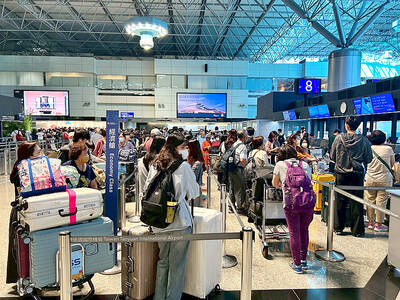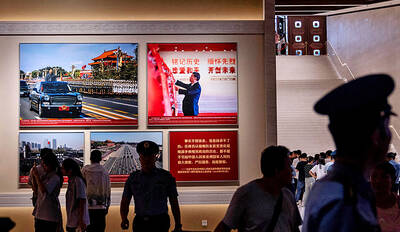A children’s picture book to promote the right to play and teach how to play with others has been published by the Ministry of Health and Welfare’s Social and Family Affairs Administration (SFAA).
Whose Slide Is It? (溜滑梯是誰的?) — available in physical form, as an e-book and as an animated video — was launched by the SFAA at an event in Taipei on Saturday.
Citing Article 31 of the UN Convention on the Rights of the Child — which recognizes the right of a child to rest and leisure, engage in play and recreational activities — the SFAA said it hopes the book promotes children’s right to play and helps develop children’s development in game reasoning.

Photo courtesy of the Ministry of Health and Welfare
The story depicts a boy who occupies a slide in a playground, but is at first unwilling to share it with other children who have different needs — such as a left-handed child and a physically disabled child.
However, through discussion, they design a suitable playground for everyone, and the children learn to play with each other.
Author Wang Wen-hua (王文華) said his inspiration for the story came from his daughter’s experience when she was a child.
There was a moment when a child occupied a slide at a park and refused to let his daughter and other children play on it, Wang said.
While his daughter cried about not being able to play, the child on the slide also cried because he had to “guard” the slide from being “taken” by others, he said.
“The playground is where many children first learn to interact with other people, and as many people want to play together, they need to talk and come up with rules,” he said.
The government in 2014 enacted the Implementation Act of the Convention on the Rights of the Child (兒童權利公約施行法) to incorporate the UN convention into domestic law.
However, children’s rights to rest and leisure, and to engage in play and recreational activities, are still often neglected, Deputy Minister of Health and Welfare Lee Li-feng (李麗芬) said.
“Children explore the world through play, and it is a process of self-development,” Lee said.
“By publishing the book, we not only hope people learn to respect children’s right to play, but also teach the meaning of ‘sharing’ with young children, so they can understand how to assist other children with special needs,” Lee said.

Three batches of banana sauce imported from the Philippines were intercepted at the border after they were found to contain the banned industrial dye Orange G, the Food and Drug Administration (FDA) said yesterday. From today through Sept. 2 next year, all seasoning sauces from the Philippines are to be subject to the FDA’s strictest border inspection, meaning 100 percent testing for illegal dyes before entry is allowed, it said in a statement. Orange G is an industrial coloring agent that is not permitted for food use in Taiwan or internationally, said Cheng Wei-chih (鄭維智), head of the FDA’s Northern Center for

The Chinese military has built landing bridge ships designed to expand its amphibious options for a potential assault on Taiwan, but their combat effectiveness is limited due to their high vulnerability, a defense expert said in an analysis published on Monday. Shen Ming-shih (沈明室), a research fellow at the Institute for National Defense and Security Research, said that the deployment of such vessels as part of the Chinese People’s Liberation Army (PLA) Navy’s East Sea Fleet signals a strong focus on Taiwan. However, the ships are highly vulnerable to precision strikes, which means they could be destroyed before they achieve their intended

About 4.2 million tourist arrivals were recorded in the first half of this year, a 10 percent increase from the same period last year, the Tourism Administration said yesterday. The growth continues to be consistent, with the fourth quarter of this year expected to be the peak in Taiwan, the agency said, adding that it plans to promote Taiwan overseas via partnerships and major events. From January to June, 9.14 million international departures were recorded from Taiwan, an 11 percent increase from the same period last year, with 3.3 million headed for Japan, 1.52 million for China and 832,962 to South Korea,

REWRITING HISTORY: China has been advocating a ‘correct’ interpretation of the victory over Japan that brings the CCP’s contributions to the forefront, an expert said An elderly Chinese war veteran’s shin still bears the mark of a bullet wound he sustained when fighting the Japanese as a teenager, a year before the end of World War II. Eighty years on, Li Jinshui’s scar remains as testimony to the bravery of Chinese troops in a conflict that killed millions of their people. However, the story behind China’s overthrow of the brutal Japanese occupation is deeply contested. Historians broadly agree that credit for victory lies primarily with the Chinese Nationalist Party (KMT)-led Republic of China (ROC) Army. Its leader, Chiang Kai-shek (蔣介石), fled to Taiwan in 1949 after losing a